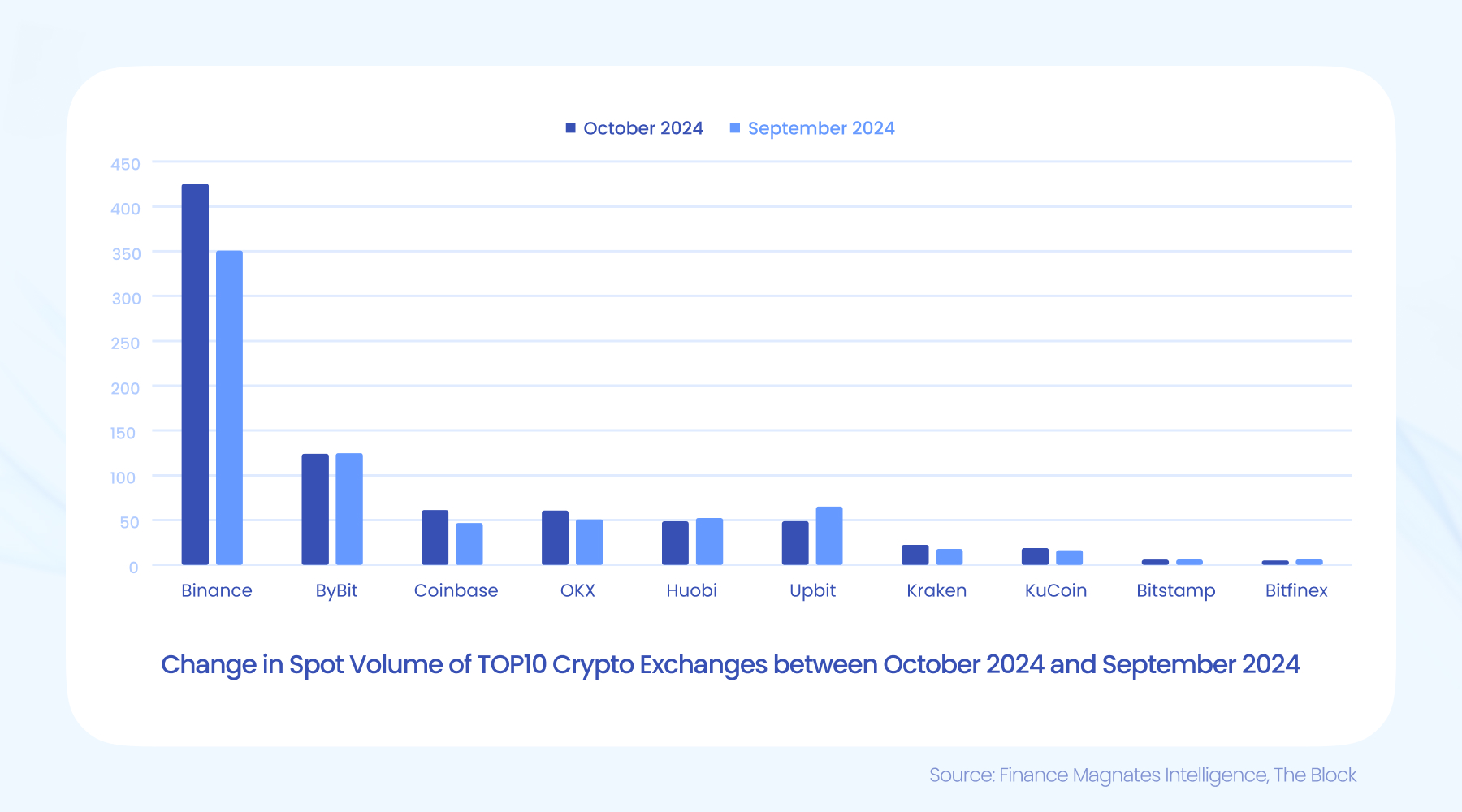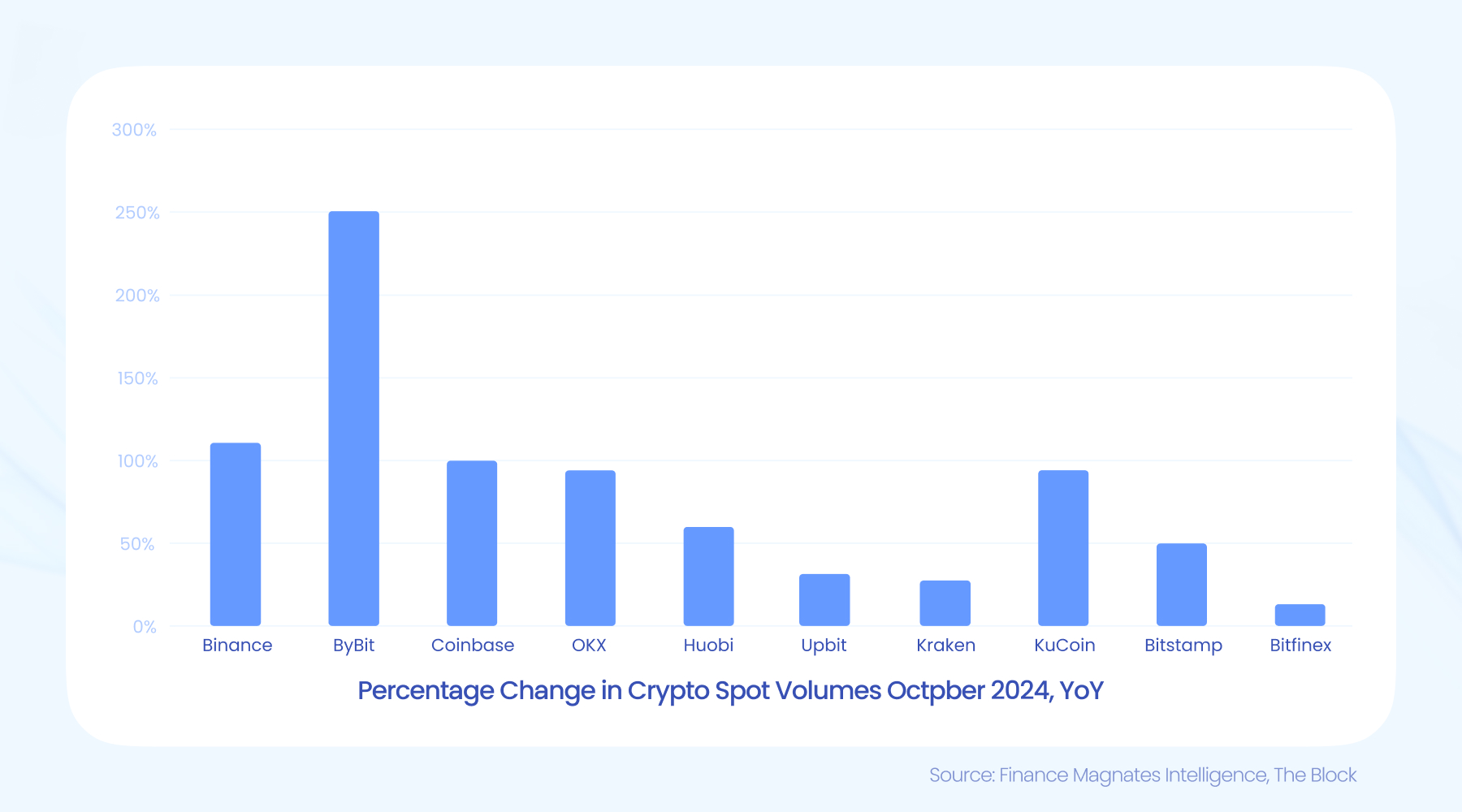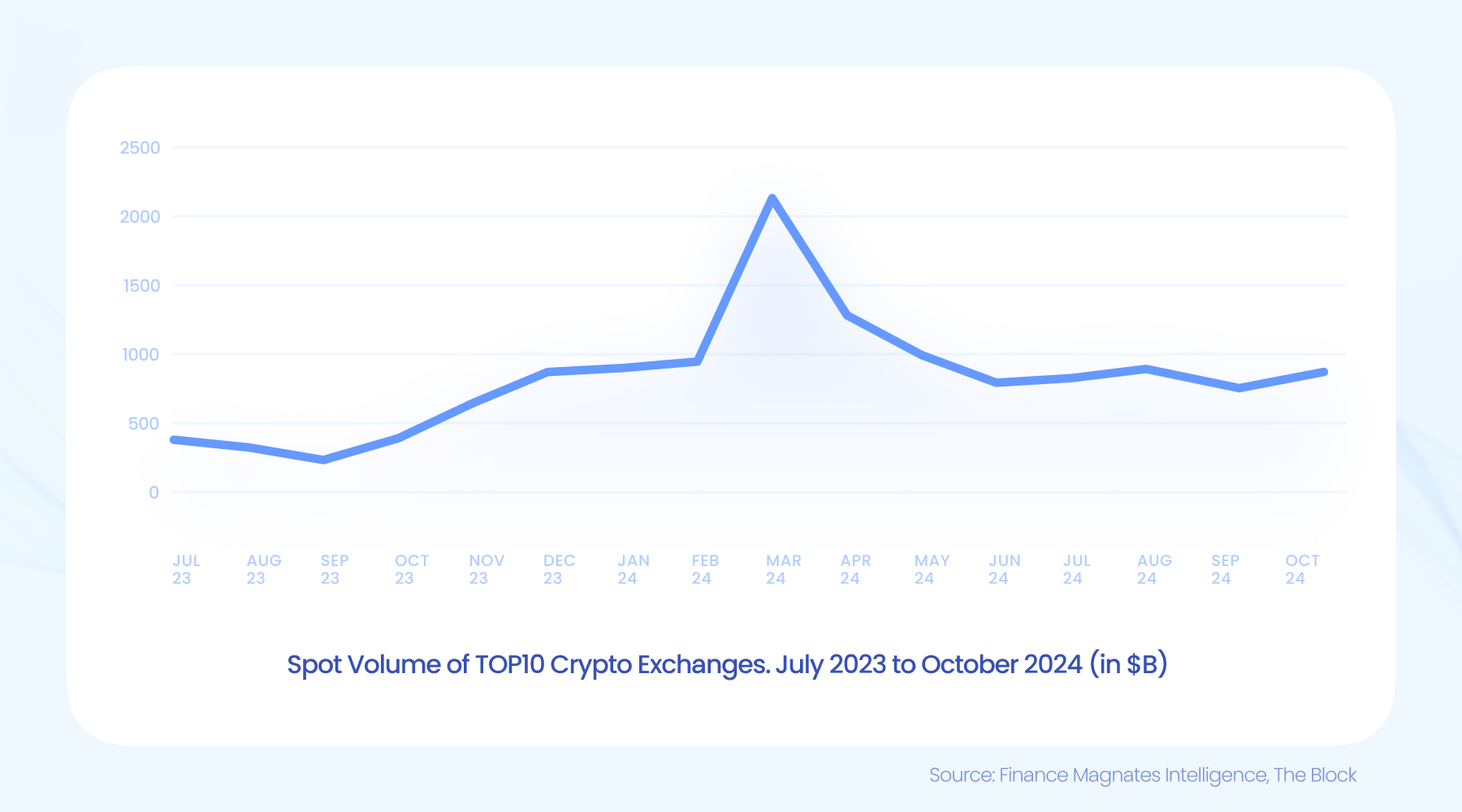Bitcoin (BTC) has grown to become one of the most traded digital assets in the world. Its trading volume reflects the immense interest in this cryptocurrency, from institutional investors to retail traders. In this article, we’ll explore the reasons behind Bitcoin’s high trading activity and how the dynamics of the crypto market drive its popularity in 2024.
In October 2024, trading volumes reached some of the highest levels this year. Compared to 2023, there was an increase of over 80%, with some exchanges experiencing growth up to 250%.
What Is Bitcoin Trading Volume?
Bitcoin trading volume refers to the total amount of Bitcoin bought and sold on exchanges within a specific time period. It’s a key metric in the cryptocurrency market, offering insights into liquidity, demand, and overall market health.
- Higher volume often indicates strong market activity and liquidity.
- Lower volume can suggest reduced interest or a more volatile market environment.
Bitcoin trading volumes can reach all-time highs during periods of market surges or significant news events. For example, during the 2021 bull run, Bitcoin volumes skyrocketed alongside its price surge. We observed the same dynamic in March 2024 and currently in October 2024.

Factors Driving High Bitcoin Trading Volume
- Institutional Adoption
Institutional investors have embraced Bitcoin as a legitimate asset class.
- Companies like MicroStrategy and Tesla have added Bitcoin to their balance sheets.
- The approval of Bitcoin Exchange-Traded Funds (ETFs), including BlackRock’s, has made it easier for financial institutions to invest.
In 2024, financial institutions processed record Bitcoin trades, boosting market liquidity.
2. Retail Investor Activity
Retail investors remain a vital part of the crypto market.
- Platforms like Coinbase and Binance allow retail traders to engage in Bitcoin trading with ease.
- During price surges, retail activity often spikes. For example, in October 2024, Coinbase saw $62.5 billion in trading volume, marking a significant rise from earlier months.

3. Global Adoption of Cryptocurrencies
Bitcoin’s appeal as a currency and store of value has spread worldwide.
- Countries like El Salvador and the Central African Republic have adopted Bitcoin as legal tender.
- Digital currencies like Bitcoin are gaining popularity as alternatives to fiat in regions facing economic instability.
4. Volatility and Speculative Trading
Bitcoin’s volatility is a double-edged sword, attracting both short-term speculators and long-term investors.
- In 2024, Bitcoin’s price crossed $92,000 after a market surge triggered by favorable regulatory developments and geopolitical changes.
- Speculators often use leverage on crypto exchanges like ByBit and OKX, amplifying trading activity.
5. Whale and Bot Activity
Whales, or entities holding large amounts of Bitcoin, often contribute to trading spikes.
- Large trades can trigger significant trading activity, influencing market sentiment.
- Trading bots also account for a portion of trading volume, especially on platforms offering algorithmic trading options.
Data: Bitcoin Trading Volume by Exchange (October 2024)
After a relatively weak September, with trading volumes dropping to the year's lowest level of $715 billion, October saw a clear rebound, reaching $820 billion. Although this figure is still far from the over $2 trillion reported in March when Bitcoin tested its all-time highs, the ongoing month of November is set to bring new records.
This is particularly notable as Bitcoin surpassed its previous historical peaks during November, climbing to $93,000. Significantly, trading volume grew sharply year-over-year, increasing by 83% compared to the $401 billion reported in October 2023. The strongest annual growth was o

Binance dominates the cryptocurrency exchange landscape, processing over half of Bitcoin's total trading volume. Smaller platforms like OKX and Huobi contribute significantly to global Bitcoin trades.
Other cryptocurrencies, such as Dogecoin (DOGE), have also played a significant role, especially as they came under speculative upward pressure following the U.S. presidential election.

Trends Behind Bitcoin’s Volume Surge
ETFs and Institutional Involvement
The lunch of Bitcoin ETFs has simplified investment for institutions.
- BlackRock’s Bitcoin ETF surpassed $34 billion in assets within months of its launch.
- Regulated futures trading on platforms like the CME has drawn institutional capital into the market.
Impact of Political Events
Global political developments have a direct impact on Bitcoin trading.
- In 2024, Donald Trump’s re-election sparked a rally in cryptocurrency prices, pushing Bitcoin to new highs.
- Market sentiment during uncertain times often turns bullish for Bitcoin, driving trading volume.
Rising Popularity of Cryptocurrencies
Bitcoin remains the most traded digital asset, but other cryptocurrencies like Ethereum and Dogecoin also influence market activity.
- Altcoins like Ethereum often rise alongside Bitcoin, contributing to the overall trading surge.
- Stablecoins such as Tether (USDT) provide liquidity to the market.
Why Volume Matters for Bitcoin
Liquidity and Price Stability
High trading volume ensures that Bitcoin remains liquid, making it easier for traders to buy or sell without impacting prices. Liquidity is essential for healthy market conditions and accurate price discovery.
Market Sentiment Indicator
Volume often reflects market sentiment. Higher volumes during a rally indicate strong investor confidence, while declining volumes may signal waning interest.
Opportunities and Risks
- Opportunities: Active markets offer arbitrage opportunities and tighter spreads.
- Risks: High volume can also attract scammers and market manipulators.
Challenges of High Trading Volume
While high trading volumes are generally positive, they come with challenges:
- Volatility spikes: High trading activity can lead to rapid price swings.
- Market manipulation: Whales and bots can distort prices and trading patterns.
- Regulatory concerns: Governments and agencies like the Securities and Exchange Commission (SEC) closely monitor high trading activity for signs of fraud or unbiased content breaches.
How Retail Investors Can Navigate High Volumes
For retail investors, understanding the dynamics of cryptocurrency trading is essential:
- Diversify Portfolios: Include stablecoins, altcoins, and Bitcoin to mitigate risks.
- Use Reliable Exchanges: Platforms like Binance and Coinbase offer secure trading environments.
- Study Market Trends: Leverage resources like CoinMarketCap and CoinGecko for original reporting on volume trends.
Why Is Bitcoin Trading Volume So High? Summing Up
Bitcoin’s high trading volume reflects its pivotal role in the crypto market. Factors such as institutional adoption, global appeal, and market volatility have contributed to its growth. As the cryptocurrency market continues to evolve, Bitcoin remains at the center of attention, influencing the behavior of traders and investors alike. By understanding the reasons behind its trading activity, participants can make informed decisions in this dynamic market.
Bitcoin Volume, FAQ
Why is crypto volume so high?
Cryptocurrency trading volume has reached unprecedented levels due to several key factors in 2024. The primary driver is Trump's victory and his pro-crypto stance, promising to make the US "the crypto capital of the planet." Additionally, the approval of spot Bitcoin ETFs has brought significant institutional money into the market, with over $19 billion in net inflows.
Why is trading volume high?
Trading volume is exceptionally high due to increased institutional participation, with the Chicago Mercantile Exchange (CME) now holding 30.6% of Bitcoin's open interest. The market has also seen improved infrastructure, reduced transaction costs, and enhanced liquidity. Major exchanges like Binance dominate with 52% market share, processing over $425 billion in monthly volume. Political factors and regulatory clarity have further boosted trader confidence.
What is the trading volume of Bitcoin?
Bitcoin's current daily trading volume consistently exceeds $33 billion as of late 2024. Monthly volumes show significant growth, with October 2024 reaching $820.21 billion across major exchanges. The first quarter of 2024 saw the highest volume at $2.1 trillion in March, followed by $1.28 trillion in April. These figures represent verified volume from legitimate exchanges, excluding wash trading and artificial inflation.
Why is Bitcoin so high?
Bitcoin reached a new all-time high of $93,495 in November 2024 due to several factors. The primary catalyst was Trump's election victory and his promises of crypto-friendly policies. The successful launch of spot Bitcoin ETFs brought unprecedented institutional investment. Additionally, improved market infrastructure, reduced transaction costs, and broader adoption by financial institutions have contributed to price appreciation. The upcoming Bitcoin halving in 2024 has also created positive market sentiment, as historically, this event has preceded significant price increases.

















